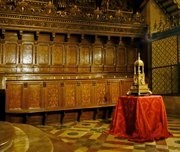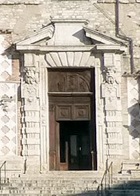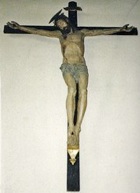Giovanni Battista Bastoni and his sons Eusebio and Girolamo were wood carvers active in Perugia.
Giovanni Battista Bastoni (died after 1532)
Giovanni Battista Bastoni was born near Perugia. He was working in the city by 1505, had a workshop in Piazza Grande by 1519, and received citizenship in 1523.
Perugia
Choir of San Girolamo (1509)
This work in San Girolamo no longer survives.
Frame for Altarpiece of Madonna degli Alberelli (1509)
In 1509, the artist Eusebio da San Giorgio was in dispute with Giovanni Battista Bastoni about the late delivery of the frame of an altarpiece. This is usually thought to be the Madonna degli Alberelli (1508-9), which Eusebio da san Giorgio painted for the Oratorio di San Benedetto. (He had a separate dispute with the Confraternita di San Benedetto about this altarpiece at the same time).
The altarpiece seems to have been removed from its original frame in the 16th century and placed in the stucco frame that survives in the ex-oratory. The original frame no longer survives. (The altarpiece is now in the Galleria Nazionale).
Work on a “Cassa” for the Sant' Agostino Polyptych (1512)
The friars of Sant’ Agostino made two commissions in the early 16th century in relation to the hugh double-sided polyptych that they had commissioned in 1495 from Perugino for the high altar of their church:
-
✴In 1512, they commissioned “una cassa per la tavola del altare maiure” from Giovanni Battista Bastoni, to a design by Perugino.
-
✴In 1520, they commissioned Eusebio da San Giorgio to complete the part of this “cassa”.
There is some dispute about what this structure was: it is variously said to have been:
-
✴the frame of the predella;
-
✴a pair of doors that would cover the altarpiece except on special occasions; or
-
✴a partition around it that would complete the separation of their choir from the rest of the church.
Whatever it was, it no longer survives.
Frame for Altarpiece of the Annunciation (1528)
This altarpiece, which is signed by Sinibaldo Ibi and dated 1528, was commissioned by the procurators of the Ospedale di Santa Maria Annunziata, the hospice owned by the Collegio dei Notai (the notaries’ guild). It was destined for the chapel in the hospice. On receipt of the altarpiece, the procurators commissioned its frame from Giovanni Battista Bastoni, to a design by Sinibaldo Ibi. The frame has been lost, although the altarpiece survives in the Galleria Nazionale.
Choir of Cappella del Santo Anello (1520-9)

The so-called Bancone dei Magistrati in the Cappella del Santo Anello of the Duomo was commissioned from Giovanni Battista Bastoni.
Eusebio Bastoni (died after 1568)
Eusebio Bastoni joined the Arte dei Maestri di Pietra e Legname (guild of stone masons and wood carvers) in 1547.
Perugia
Frame for Altarpiece (1553)
Domenico Alfani and Orazio Alfani commissioned a frame from Eusebio Bastoni that Pietro di Matteo had commissioned from them for his altar in San Francesco al Prato. The altarpiece, which is usually attributed to Orazio Alfani and which depicts the Crucifixion with SS Jerome and Apollonia, was removed from the church in 1863. The frame was lost but the panel survives in the Galleria Nazionale.
Choir of San Francesco al Prato (ca. 1560)
In 1532, the friars of San Francesco al Prato wrote to Giovanni Battista Bastoni (above), asking him to accelerate his work of the choir of their church, probably in anticipation of the consecration of the high altar in 1536. However, he probably died soon after. Eusebio Bastoni and his brother Girolamo received payment for the completion of the work in 1560.
Door of the Duomo (1568)

Crucifix (16th century)

Return to Art in: Perugia.



